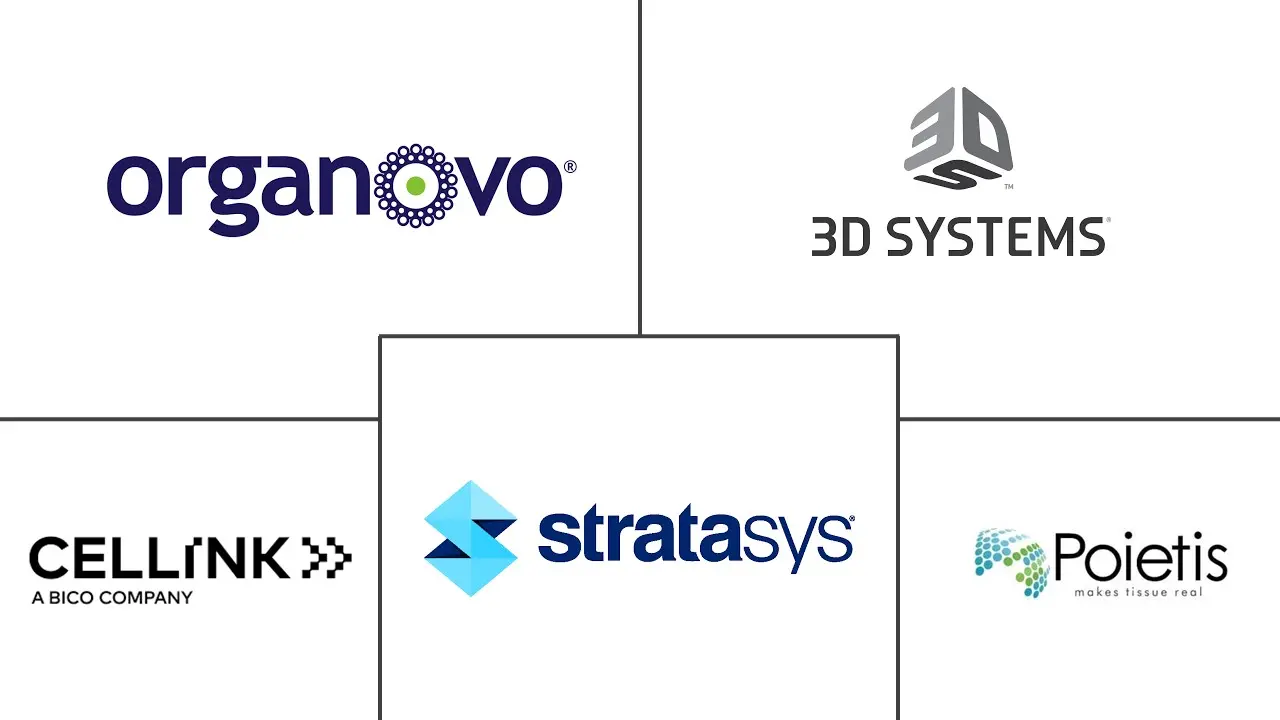4D Printing In Healthcare Market Size and Share
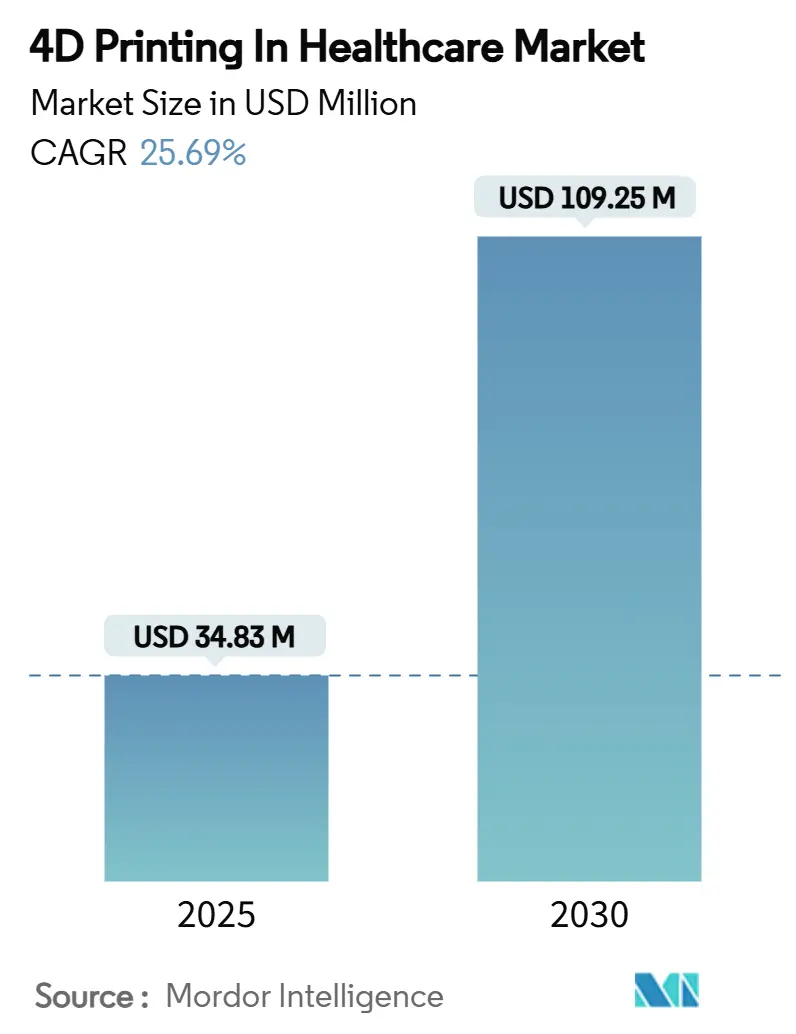
4D Printing In Healthcare Market Analysis by Mordor Intelligence
The 4D printing in healthcare market stands at USD 34.83 billion in 2025 and is forecast to reach USD 109.25 billion by 2030, registering a 25.69% CAGR. Strong demand for adaptive medical devices, advances in programmable materials and a widening set of regulatory clearances combine to accelerate revenue expansion within the 4D printing in healthcare market. Adaptive implants that reshape inside the body, shape-memory drug delivery systems and point-of-care manufacturing initiatives all reinforce adoption momentum. The technology’s potential to shorten transplant waiting lists and reduce revision surgeries attracts sustained capital inflows, while improvements in printing resolution and AI-driven material design steadily shrink development timelines. North America remains the largest regional consumer, whereas Asia-Pacific generates the fastest incremental revenue; both regions benefit from a supportive funding environment and an expanding skilled workforce.
Key Report Takeaways
- By technology, stereolithography led with 30.45% of the 4D printing in healthcare market share in 2024, while direct ink writing is projected to grow at 26.76% CAGR through 2030.
- By application, tissue engineering captured 38.32% share of the 4D printing in healthcare market size in 2024, whereas cancer therapeutics is forecast to expand at 27.54% CAGR to 2030.
- By component, programmable materials accounted for 45.73% share of the 4D printing in healthcare market size in 2024 and advance at a 26.43% CAGR through 2030.
- By end user, research institutes held 41.34% of the 4D printing in healthcare market size in 2024; pharmaceutical and biotech companies represent the fastest-growing end-user segment with 27.43% CAGR to 2030.
- By geography, North America commanded 39.76% of the 4D printing in healthcare market share in 2024, whereas Asia-Pacific is set to expand at 26.56% CAGR through 2030.
Global 4D Printing In Healthcare Market Trends and Insights
Driver Impact Analysis
| Driver | % Impact on CAGR Forecast | Geographic Relevance | Impact Timeline |
|---|---|---|---|
| Growing organ transplant waiting lists | +2.3% | Global, acute shortages in North America and Europe | Long term (≥ 4 years) |
| Expanding bioprinting research funding | +1.8% | North America and Asia-Pacific, spill-over to Europe | Medium term (2-4 years) |
| Rapid adoption of personalized medicine | +2.1% | Global, led by developed markets | Medium term (2-4 years) |
| Emergence of adaptive implant regulatory pathways | +1.2% | North America and Europe, expanding to Asia-Pacific | Long term (≥ 4 years) |
| Integration of AI-driven material programming | +1.9% | Global, concentrated in tech-advanced regions | Short term (≤ 2 years) |
| Hospital point-of-care manufacturing initiatives | +1.4% | North America and Europe, pilots in Asia-Pacific | Medium term (2-4 years) |
| Source: Mordor Intelligence | |||
Growing Organ Transplant Waiting Lists
More than 100,000 Americans remain on transplant waiting lists, and comparable shortages persist worldwide, which elevates 4D-printed grafts and scaffolds from experimental projects to essential clinical tools[1]Food and Drug Administration, “Emerging Technology Program,” fda.gov. Adaptive vascular constructs printed with cell-laden bioinks can expand or stiffen as tissue forms, a property that aligns closely with complex organ architecture. Health-system spending on end-stage organ failure drives additional interest in lowering lifetime treatment costs. Regulatory agencies now acknowledge 4D printing as a feasible pathway for future organ replacement, strengthening investor confidence and driving fresh capital towards the 4D printing in healthcare market.
Rapid Adoption of Personalized Medicine
Precision-medicine strategies dovetail with printed devices that respond to individual biomechanics. AI-enabled design algorithms generate cardiovascular implants that adapt to changing hemodynamic forces, delivering fit and function unattainable with static parts[2]Frontiers in Bioengineering and Biotechnology, “AI-enabled smart cardiovascular implants,” frontiersin.org. Shape-memory drug capsules release molecules at pre-programmed pH thresholds, improving therapeutic windows. Hospitals report lower revision rates when patient-specific constructs replace off-the-shelf implants, strengthening the economic case for broader deployment across the 4D printing in healthcare market.
Integration of AI-Driven Material Programming
Machine-learning models predict complex shape changes in smart polymers, slashing design cycles and boosting device reliability[3]Nature Communications, “Machine learning-based prediction of shape-shifting behavior in 4D-printed active plates,” nature.com. Generative algorithms now optimize bioink formulation, ensuring consistent cell viability and mechanical strength. As closed-loop feedback systems mature, implants will adjust autonomously to biomarker fluctuations, reinforcing the value proposition of the 4D printing in healthcare market.
Hospital Point-of-Care Manufacturing Initiatives
Academic medical centers equip surgical suites with compact 4D printers that fabricate patient-specific guides within hours. Early programs in Boston, London and Seoul demonstrate reduced operating time and lower inventory costs. Successful pilots encourage regional replication, energizing capital equipment demand within the 4D printing in healthcare market.
Restraints Impact Analysis
| Restraints Impact Analysis | (~) % Impact on CAGR Forecast | Geographic Relevance | Impact Timeline |
|---|---|---|---|
| High capital and material costs | -2.8% | Global, more pronounced in emerging markets | Short term (≤ 2 years) |
| Limited clinical validation and standards | -1.9% | Global, regulation-dependent regions | Medium term (2-4 years) |
| Complex regulatory approval processes | -1.6% | Global, strictest in North America and Europe | Medium term (2-4 years) |
| Supply chain constraints for smart biomaterials | -1.4% | Global, intensified in regions with limited supplier base | Short term (≤ 2 years) |
| Source: Mordor Intelligence | |||
High Capital and Material Costs
Specialized printers often exceed USD 500,000 while smart biomaterials can cost 10–20 times more than conventional polymers, limiting access for smaller clinics. Limited supplier pools add procurement risk and prolong lead times. Skilled technicians command premium remuneration, elevating total cost of ownership. Although unit costs should decline as production scales, current economics still restrain broad adoption inside the 4D printing in healthcare market.
Limited Clinical Validation and Standards
Time-dependent behavior complicates traditional bench testing. Regulators require longitudinal evidence that adaptive implants remain safe throughout their lifecycle, yet harmonized test protocols are scarce. A lack of standardized material specifications challenges quality assurance for multi-site manufacturing. Slow approvals extend development spending, deterring newcomers and exerting drag on growth across the 4D printing in healthcare market.
Segment Analysis
By Technology: Stereolithography Strengthens Precision Leadership
Stereolithography recorded a 30.45% slice of the 4D printing in healthcare market in 2024. The modality delivers sub-100 µm feature resolution and smooth surface finishes, ideal for cranio-maxillofacial implants and microfluidic drug pumps. Hospitals appreciate its predictable print-to-part accuracy, which improves surgical rehearsal outcomes. Competitive entrants combine optical systems with oxygen-inhibition layers to boost throughput, underscoring SLA’s staying power inside the 4D printing in healthcare market.
Direct ink writing is set to grow at 26.76% CAGR through 2030. Its ability to co-deposit hydrogels and ceramic pastes enables multi-phase constructs that mimic native bone–cartilage transitions. Selective laser sintering maintains relevance for load-bearing orthopedic parts, while PolyJet technology expands into multi-durometer catheters. Hybrid machines merge extrusion and vat-photopolymerization inside one frame, suggesting future convergence that could reshape supplier dynamics.
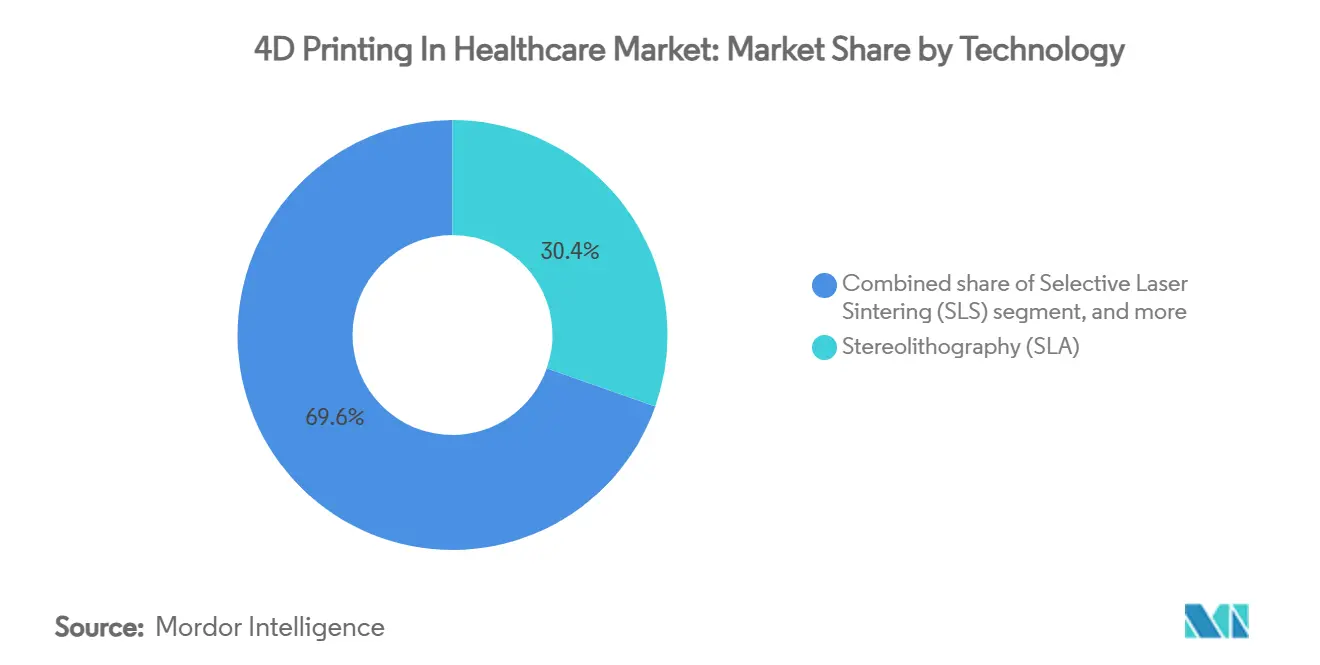
By Application: Tissue Engineering Anchors Revenues
Tissue engineering captured 38.32% of the 4D printing in healthcare market size in 2024. Researchers exploit anisotropic scaffolds that expand or stiffen as cells deposit extracellular matrix, guiding organoid maturation. Hospitals pilot cartilage patches that conform to joint curvature after implantation, strengthening clinical evidence. Cancer therapeutics, expected to compound at 27.54% annually, leverages shape-memory hydrogels that swell selectively in acidic tumor niches, enabling precise chemotherapeutic release. The synergy between live-cell printing and immunotherapy promises further upside for the 4D printing in healthcare market.
Drug and cell delivery constructs now incorporate micro-valves that open in response to glucose or lactate, supporting chronic disease management. Adaptive surgical guides fold for minimally invasive insertion then unfold on-site, reducing incision length. Orthotic devices integrate pressure-sensing networks that alter stiffness during gait, enhancing rehabilitation outcomes.
By Component: Programmable Materials Dominate Functionality
Programmable materials represented 45.73% of total revenue in 2024 and remain the fastest-growing component at 26.43% CAGR. Shape-memory polymers respond to body temperature, while photo-curable hydrogels align with visible-light printers, broadening clinical compatibility. Vendors now distribute ISO-13485-certified resin cartridges, simplifying hospital validation and fueling further demand across the 4D printing in healthcare market.
Hardware suppliers integrate closed-loop sensors that track chamber humidity and viscosity in real time, ensuring batch consistency. Software revenue climbs as AI-enabled platforms simulate morphing behavior before material deposition. Post-processing equipment, including smart curing chambers and sterilization tunnels, completes the ecosystem and deepens barriers to entry.
By End User: Research Institutes Pioneer Translation
Academic laboratories held 41.34% of the 4D printing in healthcare market size in 2024. Multidisciplinary teams combine materials science, cell biology and computational modeling to develop organ-scale constructs that meet pre-clinical milestones. Their publications spur partnerships with device companies seeking translational know-how. Pharmaceutical and biotech firms, forecast to expand at 27.43% CAGR, integrate 4D platforms into drug-screening workflows, enabling dynamic tumor models that better predict in-vivo efficacy.
Hospitals adopt compact printers for on-demand surgical guides and adaptive implants, particularly in orthopedic oncology where margins and timing are critical. Contract manufacturers bridge capability gaps for community hospitals, providing ISO-compliant production as a service and broadening downstream access to the 4D printing in healthcare market.
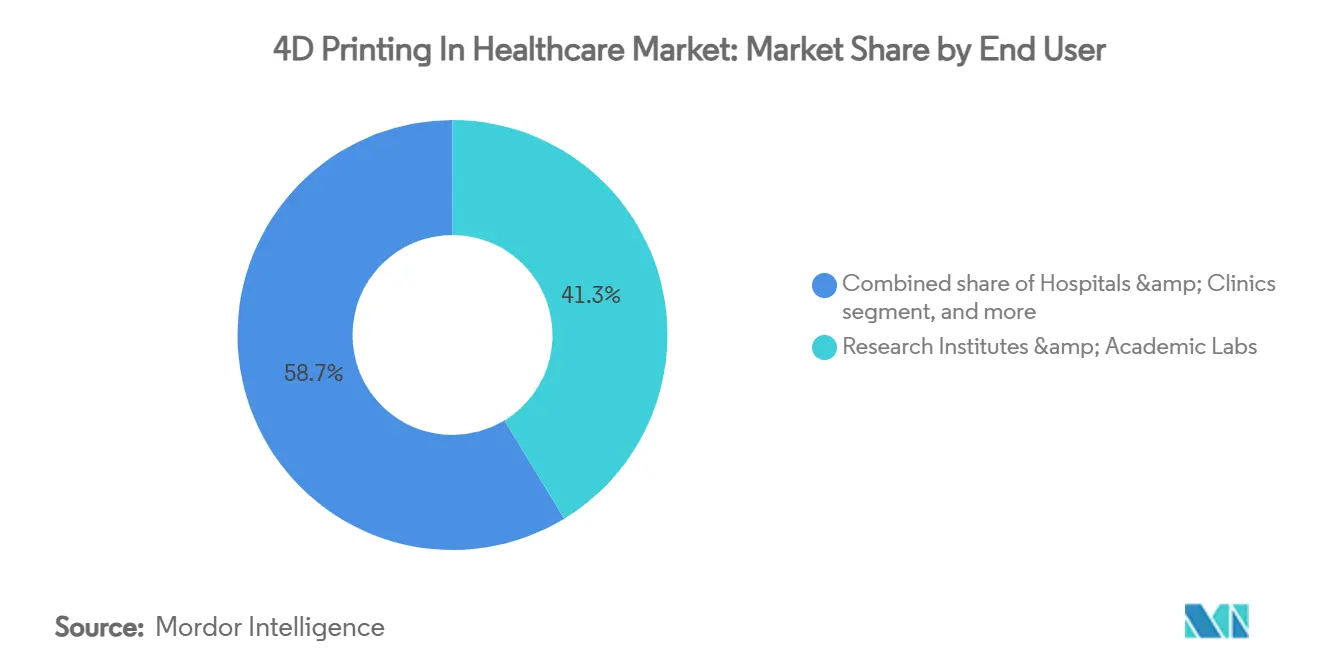
Note: Segment shares of all individual segments available upon report purchase
Geography Analysis
North America led in 2024 with a 39.76% revenue share, anchored by extensive NIH funding, deep venture capital pools and FDA recognition of 4D printing as an emerging technology. Clinical collaborations at MIT and the University of Illinois Chicago generate high-impact patents and early human-use cases, reinforcing the region’s dominance. Canada’s government grant to Aspect positions the country as a bioprinting pioneer. Integration of hospital-based additive manufacturing units accelerates time-to-patient delivery.
Asia-Pacific is projected to expand at 26.56% CAGR to 2030. China leads in peer-reviewed publications and benefits from large-scale government programs to localize high-value medical technology. South Korea develops respiratory organoid models for inhalation research, while Japan’s aging demographic fuels demand for adaptive implants that limit revision surgeries. Australia invests in regenerative therapy hubs that produce smart scaffolds for export within the 4D printing in healthcare market.
Europe holds strong research credentials. The United Kingdom’s multi-institutional 4D device initiative complements Germany’s industrial machinery expertise and Switzerland’s precision biomaterial synthesis. Though rigorous CE regulations extend approval timelines, they assure downstream payers of device safety and durability. The Middle East and Africa evaluate leapfrog strategies that circumvent legacy production, whereas South America modernizes orthopedic centers by adopting contract printing partnerships.
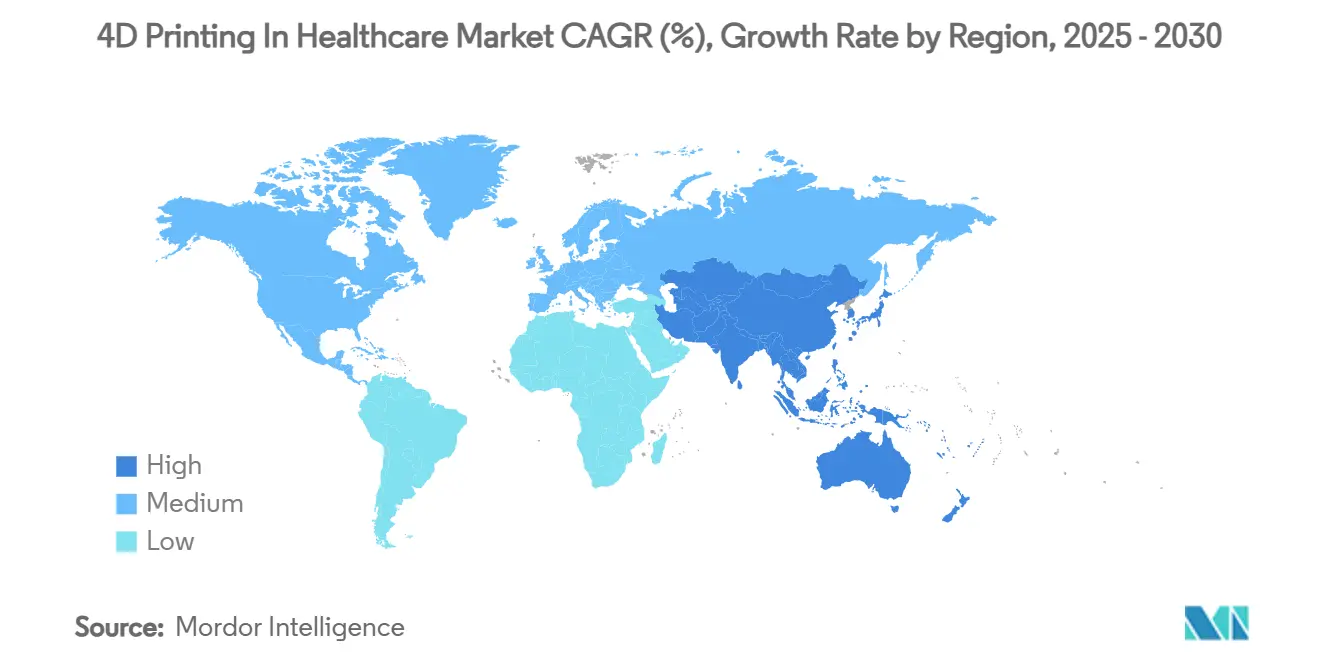
Competitive Landscape
The 4D printing in healthcare market shows moderate fragmentation with intensifying patent activity. Materialise posted 14.3% Medical-segment revenue growth during Q4 2024; its acquisition of FEops adds AI-based simulation that optimizes morphing heart valves. Stratasys collaborates with CollPlant to develop collagen-based breast implants, illustrating alliances that marry smart biomaterials with scalable printers. 3D Systems achieved the first MDR-compliant PEEK facial implant, confirming European regulatory traction.
Start-ups secure funding by targeting niches such as resorbable photocurable resins and pediatric-ready implants. 4D Medicine raised GBP 3.4 million to accelerate its 4Degra platform, while VoxCell BioInnovation advances vascularized tumor tissue for drug testing. Intellectual-property portfolios increasingly cover software algorithms that predict actuator paths, complicating entry for new competitors. Consolidation is expected as large incumbents acquire material specialists to secure supply chains and expand service bundles inside the 4D printing in healthcare market.
4D Printing In Healthcare Industry Leaders
-
Stratasys Ltd
-
3D Systems Corp
-
Organovo Holdings Inc.
-
Cellink (BICO Group)
-
Poietis SA
- *Disclaimer: Major Players sorted in no particular order
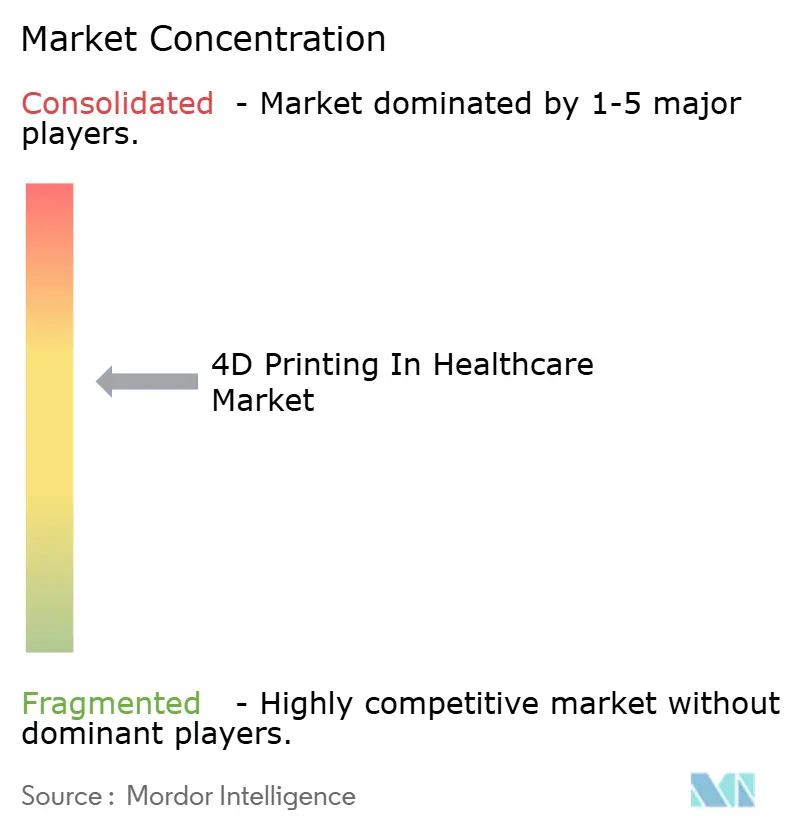


Recent Industry Developments
- April 2025: UK universities launched a collaborative 4D medical device manufacturing project to develop adaptive health tech devices Medical Device Network.
- April 2025: Restor3d received USD 38 million to accelerate new 3D-printed orthopedic lines FinSMEs.
- March 2025: 3D Systems reported the first MDR-compliant PEEK facial implant at University Hospital Basel 3D Systems.
- February 2025: VoxCell BioInnovation raised USD 1.73 million, bringing total funding to USD 4.54 million Tracxn.
- January 2025: Synopsys announced the USD 35 billion acquisition of Ansys, strengthening multiphysics simulation for additive manufacturing 3D Printing Journal.
Global 4D Printing In Healthcare Market Report Scope
4D printing in healthcare aims to construct complex forms that can transform their properties upon response to internal or external stimuli to repair, replace, or regrow diseased or damaged tissues, cells, and organs.
The market for 4D printing in healthcare is segmented by technology, application, component, end user, and geography. By technology, the market is segmented into stereolithography, selective laser sintering (SLS), polyjet, and fusion deposition modeling (FDM). The market is segmented into tissue engineering, drug delivery, and patient-specific implant by application. By component, the market is divided into software and services, equipment, and programmable material. By end user, the market is segmented into hospitals and clinics, research institutes, and others. By geography, the market is segmented into North America, Europe, Asia-Pacific, Middle East and Africa and South America. The report covers the estimated market sizes and trends for 17 countries across major regions globally. The report offers value (USD) for all the above segments.
| Stereolithography (SLA) |
| Selective Laser Sintering (SLS) |
| PolyJet / Material Jetting |
| Fused Deposition Modelling (FDM) |
| Direct Ink Writing (DIW) |
| Digital Light Processing (DLP) |
| Multi-Jet Fusion (MJF) |
| Tissue Engineering & Regenerative Medicine |
| Drug & Cell Delivery Systems |
| Patient-Specific Implants & Prosthetics |
| Surgical Instruments & Guides |
| Wearable / Smart Orthotics |
| Dental & Cranio-Maxillofacial |
| Cancer Therapeutics |
| Software & Services |
| Equipment (4D Printers & Ancillary) |
| Programmable Materials |
| Hospitals & Clinics |
| Research Institutes & Academic Labs |
| Pharmaceutical & Biotech Companies |
| Contract Manufacturing Organizations (CMOs) |
| North America | United States |
| Canada | |
| Mexico | |
| Europe | Germany |
| United Kingdom | |
| France | |
| Italy | |
| Spain | |
| Rest of Europe | |
| Asia-Pacific | China |
| Japan | |
| India | |
| Australia | |
| South Korea | |
| Rest of Asia-Pacific | |
| Middle East & Africa | GCC |
| South Africa | |
| Rest of Middle East & Africa | |
| South America | Brazil |
| Argentina | |
| Rest of South America |
| By Technology | Stereolithography (SLA) | |
| Selective Laser Sintering (SLS) | ||
| PolyJet / Material Jetting | ||
| Fused Deposition Modelling (FDM) | ||
| Direct Ink Writing (DIW) | ||
| Digital Light Processing (DLP) | ||
| Multi-Jet Fusion (MJF) | ||
| By Application | Tissue Engineering & Regenerative Medicine | |
| Drug & Cell Delivery Systems | ||
| Patient-Specific Implants & Prosthetics | ||
| Surgical Instruments & Guides | ||
| Wearable / Smart Orthotics | ||
| Dental & Cranio-Maxillofacial | ||
| Cancer Therapeutics | ||
| By Component | Software & Services | |
| Equipment (4D Printers & Ancillary) | ||
| Programmable Materials | ||
| By End User | Hospitals & Clinics | |
| Research Institutes & Academic Labs | ||
| Pharmaceutical & Biotech Companies | ||
| Contract Manufacturing Organizations (CMOs) | ||
| Geography | North America | United States |
| Canada | ||
| Mexico | ||
| Europe | Germany | |
| United Kingdom | ||
| France | ||
| Italy | ||
| Spain | ||
| Rest of Europe | ||
| Asia-Pacific | China | |
| Japan | ||
| India | ||
| Australia | ||
| South Korea | ||
| Rest of Asia-Pacific | ||
| Middle East & Africa | GCC | |
| South Africa | ||
| Rest of Middle East & Africa | ||
| South America | Brazil | |
| Argentina | ||
| Rest of South America | ||


Key Questions Answered in the Report
What is driving the current growth of the 4D printing in healthcare market?
Sizeable transplant waiting lists, rapid personalised-medicine adoption and expanding research grants collectively push the market to a 25.69% CAGR through 2030.
Which technology holds the largest share in the 4D printing in healthcare market?
Stereolithography leads with a 30.45% share due to its high resolution and compatibility with photocurable smart polymers.
How big is the 4D printing in healthcare market size for programmable materials?
Programmable materials accounted for 45.73% of overall revenue in 2024 and will grow at 26.43% CAGR.
Which region is projected to grow fastest?
Asia-Pacific is forecast to expand at 26.56% CAGR through 2030, supported by strong government funding and manufacturing capacity.
What is the main restraint on wider adoption?
High capital equipment costs and premium pricing for smart biomaterials currently limit access for smaller institutions.
Are there established regulatory pathways for 4D-printed implants?
The FDA and European regulators now recognise adaptive implants as an emerging category, and early approvals such as MDR-compliant PEEK facial implants signal a clearer path forward.
Page last updated on:
